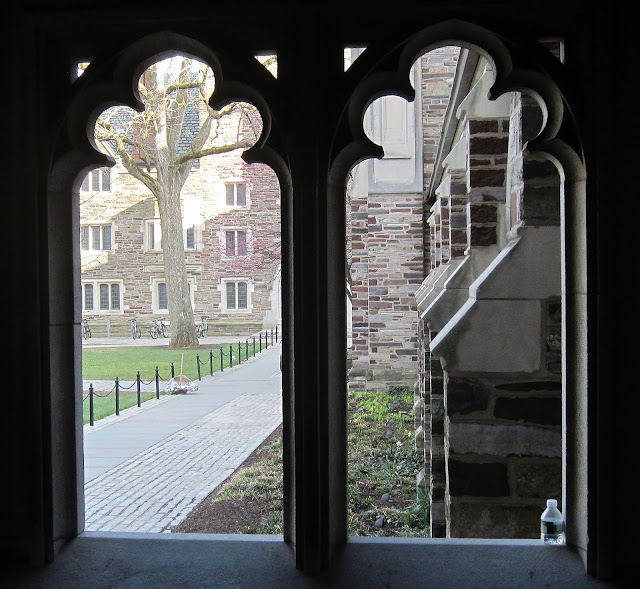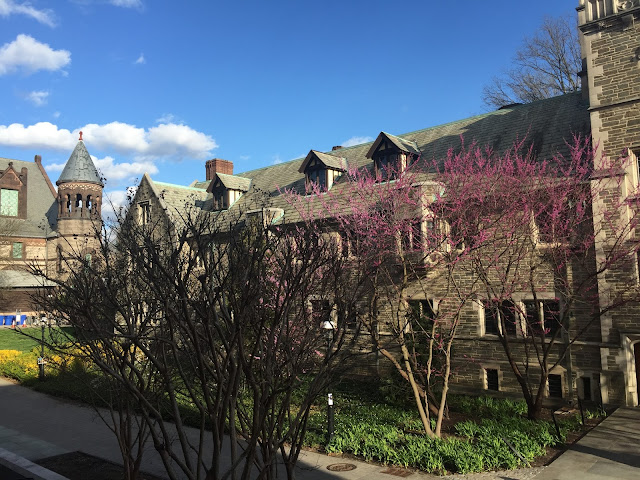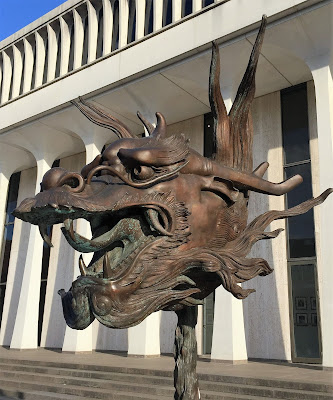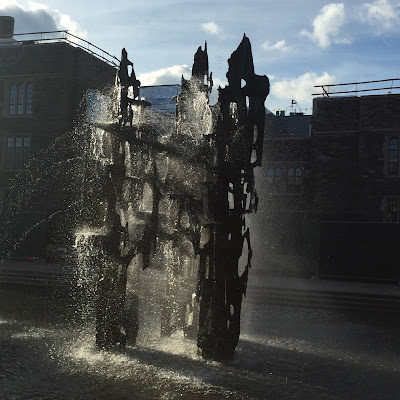Princeton University, founded in 1746, was the fourth college in the colonies. First was Harvard, then the College of William and Mary, then Yale, and then Princeton. What's so cool about Princeton? Its alumni include:
Just walking around campus made us feel smart (at least as smart as this little boy trying to get the last drop out of the barrel):


On the Princeton University Campus itself, we admired the tower of the John D. Rockefeller College (named after JDR III, brother of Nelson Rockefeller, and yes, he was an alumnus, class of 1929):
Princeton is made up of six different colleges, each with its own area of campus. We entered the university through the John D. Rockefeller III campus:
. . . and then we just wandered around admiring the Gothic architecture and the surprisingly normal-looking students, feeling alternately brilliant and stupid:
I think the only school that rivals Princeton's elegance and beauty is Yale University.
Everything is NOT as old as it looks. This is faux old, having been built from 1877 on.
 F. Scott Fitzgerald's debut novel, published in 1920 when he was just 24 years old, tells the largely autobiographical story of Amory Blaine, a young, immature Princeton student who would rather talk and party than go to class and study. Amory eventually enlists in the army and is sent overseas during World War I, and upon his return, he falls in love with a wealthy debutante who ultimately rejects him because of his lack of money, causing Amory to go on a three-week drinking binge.
F. Scott Fitzgerald's debut novel, published in 1920 when he was just 24 years old, tells the largely autobiographical story of Amory Blaine, a young, immature Princeton student who would rather talk and party than go to class and study. Amory eventually enlists in the army and is sent overseas during World War I, and upon his return, he falls in love with a wealthy debutante who ultimately rejects him because of his lack of money, causing Amory to go on a three-week drinking binge.
That sounds a lot like Scott and Zelda, doesn't it? Like the protagonist, Scott also attended Princeton and had a lackluster record. He enlisted in the army, but was stationed in Alabama rather than overseas. It was in Alabama that he met Zelda, who refused to marry into poverty. Ironically, it was the sale of this book that finally convinced Zelda to marry Scott. This Side of Paradise was a huge monetary and critical success, launching the Fitzgeralds into a lifestyle that mirrored the shallow, decadent lifestyle of so many of Fitzgerald's later characters.
 A. Scott Berg, the Pulitzer Prize-winning biographer of Charles Lindbergh, graduated from Princeton himself, and so his recounting of Woodrow Wilson's years as the school's president from 1902 to 1910 is especially insightful. Besides Wilson's time at Princeton, Berg analyzes Wilson's childhood, education, life in academia in general, family life, two marriages, and two terms as President of the United States.
A. Scott Berg, the Pulitzer Prize-winning biographer of Charles Lindbergh, graduated from Princeton himself, and so his recounting of Woodrow Wilson's years as the school's president from 1902 to 1910 is especially insightful. Besides Wilson's time at Princeton, Berg analyzes Wilson's childhood, education, life in academia in general, family life, two marriages, and two terms as President of the United States.
Berg also analyzes the impact of the crippling stroke that Wilson suffered in October 1919 on the post-World War I peacemaking efforts, and theorizes how Wilson's touch may have added the pieces that may have prevented World War II.
A MOVIE (AND A BOOK):
 The brilliant mathematician John Nash entered Princeton University in 1948 as a graduate student, having already attained a BS and MS in mathematics from Carnegie Institute of Technology in Pittsburgh. He received his PhD in 1950, and during those two years he developed what is now known as the "Nash Equilibrium," a concept that won him the Nobel Prize in economics in 1994.
The brilliant mathematician John Nash entered Princeton University in 1948 as a graduate student, having already attained a BS and MS in mathematics from Carnegie Institute of Technology in Pittsburgh. He received his PhD in 1950, and during those two years he developed what is now known as the "Nash Equilibrium," a concept that won him the Nobel Prize in economics in 1994.
The movie A Beautiful Mind, based on Sylvia Nassar's 1998 Pulitzer Prize-nominated book of the same name, won four Academy Awards in 2001: Best Picture, Best Director, Best Adapted Screenplay, and Best Supporting Actress. There is a fair amount of filming done on the Princeton University campus, making it fun to watch if you've been to Princeton and can identify the various locations.
41 Nobel laureates
21 National Medal of Science winners
14 Fields Medalists
10 Turing Award laureates
5 National Humanities Medal winners
209 Rhodes Scholars
126 Marshall Scholars
2 U.S. Presidents (James Madison, Woodrow Wilson)
1 U.S. Vice President (Aaron Burr)
1 First Lady (Michelle Obama)
12 U.S. Supreme Court Justices
Bunches of members of Congress and Cabinet members
Lots of other famous people (e.g., Jeff Bezos, Jimmy Stewart,
Brooke Shields, Lee Iacocca, Alan Turing)
Just walking around campus made us feel smart (at least as smart as this little boy trying to get the last drop out of the barrel):


On the Princeton University Campus itself, we admired the tower of the John D. Rockefeller College (named after JDR III, brother of Nelson Rockefeller, and yes, he was an alumnus, class of 1929):
Princeton is all about Old World elegance and Gothic architecture and being prim and proper . . . or so we thought until we happened upon Scudder Plaza, a large open area in front of the Woodrow Wilson School of Public and International Affairs adorned by this installation by Chinese artist and activist Ai Weiwei, known for his collaboration in the design of the "Bird's Nest" stadium in Beijing for the 2008 Summer Olympics.
Definitely NOT Gothic and NOT prim and proper.
Each head represents a symbol of the zodiac: snake, horse, ram, monkey, rooster, pig, dog, rat, ox, tiger, rabbit, and dragon. The bronze sculptures stand about 10 feet tall and were installed facing a fountain in front of the building in August 2012 with the plan to keep them there for a year. Well, we saw them in April 2016, so it looks like their stay has been extended.
What are the animals all looking at? The Fountain of Freedom, one of the largest bronze castings in the United States:
Standing in the middle of a shallow reflecting pool, that sculpture is supposed to represent Woodrow Wilson's vision of lasting peace. Wilson himself was the President of Princeton from 1902-1910, after which he was Governor of New Jersey from 1911-1913, after which he was President of the United States from 1913 to 1921. Yes indeed, Princeton is a good stepping stone to greater things.
Ironically, the statue reminds me of what was left of the mangled Twin Towers after 9/11. What do you think?
READING:
 F. Scott Fitzgerald's debut novel, published in 1920 when he was just 24 years old, tells the largely autobiographical story of Amory Blaine, a young, immature Princeton student who would rather talk and party than go to class and study. Amory eventually enlists in the army and is sent overseas during World War I, and upon his return, he falls in love with a wealthy debutante who ultimately rejects him because of his lack of money, causing Amory to go on a three-week drinking binge.
F. Scott Fitzgerald's debut novel, published in 1920 when he was just 24 years old, tells the largely autobiographical story of Amory Blaine, a young, immature Princeton student who would rather talk and party than go to class and study. Amory eventually enlists in the army and is sent overseas during World War I, and upon his return, he falls in love with a wealthy debutante who ultimately rejects him because of his lack of money, causing Amory to go on a three-week drinking binge.That sounds a lot like Scott and Zelda, doesn't it? Like the protagonist, Scott also attended Princeton and had a lackluster record. He enlisted in the army, but was stationed in Alabama rather than overseas. It was in Alabama that he met Zelda, who refused to marry into poverty. Ironically, it was the sale of this book that finally convinced Zelda to marry Scott. This Side of Paradise was a huge monetary and critical success, launching the Fitzgeralds into a lifestyle that mirrored the shallow, decadent lifestyle of so many of Fitzgerald's later characters.
 A. Scott Berg, the Pulitzer Prize-winning biographer of Charles Lindbergh, graduated from Princeton himself, and so his recounting of Woodrow Wilson's years as the school's president from 1902 to 1910 is especially insightful. Besides Wilson's time at Princeton, Berg analyzes Wilson's childhood, education, life in academia in general, family life, two marriages, and two terms as President of the United States.
A. Scott Berg, the Pulitzer Prize-winning biographer of Charles Lindbergh, graduated from Princeton himself, and so his recounting of Woodrow Wilson's years as the school's president from 1902 to 1910 is especially insightful. Besides Wilson's time at Princeton, Berg analyzes Wilson's childhood, education, life in academia in general, family life, two marriages, and two terms as President of the United States.Berg also analyzes the impact of the crippling stroke that Wilson suffered in October 1919 on the post-World War I peacemaking efforts, and theorizes how Wilson's touch may have added the pieces that may have prevented World War II.
A MOVIE (AND A BOOK):
 The brilliant mathematician John Nash entered Princeton University in 1948 as a graduate student, having already attained a BS and MS in mathematics from Carnegie Institute of Technology in Pittsburgh. He received his PhD in 1950, and during those two years he developed what is now known as the "Nash Equilibrium," a concept that won him the Nobel Prize in economics in 1994.
The brilliant mathematician John Nash entered Princeton University in 1948 as a graduate student, having already attained a BS and MS in mathematics from Carnegie Institute of Technology in Pittsburgh. He received his PhD in 1950, and during those two years he developed what is now known as the "Nash Equilibrium," a concept that won him the Nobel Prize in economics in 1994.The movie A Beautiful Mind, based on Sylvia Nassar's 1998 Pulitzer Prize-nominated book of the same name, won four Academy Awards in 2001: Best Picture, Best Director, Best Adapted Screenplay, and Best Supporting Actress. There is a fair amount of filming done on the Princeton University campus, making it fun to watch if you've been to Princeton and can identify the various locations.


























It was so fun to visit Princeton University. It would really be fun to be able to go to school there. Fun information in your post.
ReplyDeleteIt would be fun to go to school at Princeton. Except for the hefty tuition bill. I think a visit would be nearly as much fun and much cheaper.
ReplyDeleteI agree with you about the "Peace" statue--it looks more like the remnants of war.